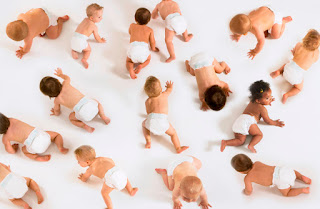Another industry stirred by the coronavirus pandemic is the Sperm World. With the industry not strictly regulated, accurate numbers are difficult to find. In the 1980s, research had estimated the number of children born by donor sperm in the USA was between 30,000 and 60,000 every year. Now with the legalization of gay marriages and gay unions in many countries, the market has dramatically expanded.
In the estimate of Sperm banks in the developed world
(USA, Europe, Australia), about 20% of sperm bank clients are infertile straight
couples, 60% are gay women, and 20% are single mothers wanting to have and raise
own children without a male partner.
*****
Two things have happened since the start of the
pandemic. The demand has shot up everywhere, reaching record levels in the USA,
England, Australia and Canada. People working from home (perhaps naïvely) think
life now has the flexibility that will allow them to have children. It may also
be a way to reduce the gloom or quarantine loneliness.
On the other hand, supply of sperm has dramatically declined,
(or should I say drying up). Big sperm banks are running low. To meet the growing
demand, men were visiting sperm banks regularly for years. In coronavirus
times, they were scared to go. During lockdowns, new donor recruitment stopped,
and hasn’t yet restarted. “Smart sperm”, aspired to by many, has become
difficult to get.
*****
What is smart sperm? Graduate sperm. Preferably bright
graduate sperm. You can’t blame a woman for wishing her sperm donor is from
Harvard or Stanford. As a matter of fact, many big sperm banks are located near
elite colleges. They have sperm collection centers in Palo Alto near Stanford
university, and Cambridge, near Harvard university. It’s a mutually beneficial arrangement
where academically bright young men can perpetuate their stock by spreading fifty
or so biological children around the world.
College educated sperm is something women are willing
to pay more for. In pre-pandemic times, those donors would go to a bank once or
twice a week over months to produce enough sperm to sell to dozens of families.
*****
Sperm prices have gone up. But the bigger disturbance
in the Sperm World is that women are joining unregulated Facebook groups to bypass
the sperm banks. The FB groups connect the buyers and the potential donors,
getting rid of the middlemen. Kyle Gordy, 29, has founded a private FB group “Sperm
Donation USA” that already has 12700 members. Gordy himself has sired 35 children
till date, with five more on the way. Private donors are super-busy. They can contact
the mothers-to-be directly.
England and Australia make it illegal for sperm donors
to charge significant amounts of money (even if they are from Harvard or Oxford).
In the USA, FDA regulates sperm donation the way it regulates tissue donation.
A donor must donate sperm of his free will. Payment should never be his primary
motivation. Usually, the payments are considered as reimbursement for travel
and time.
Though donors are technically not allowed to charge for
donation, buying sperm from a sperm bank is expensive for the buyer. Each vial
from a premium sperm bank can cost up to $1100. The bank guarantees a vial will
have 10-15 million total motile sperm. Each month, during the prospective
mother’s ovulation, her doctor unthaws the vial and injects the sperm.
Sperm banks recommend buying four or five vials per child,
since the process can take months for a successful pregnancy. Donors are in
demand. If a woman wants to have two children from the same donor, she needs to
invest at least $10,000.
In the pandemic, the sperm king donors are exhausted.
They are flying and driving around; shipping sperm in vials; taking the latest
DNA tests because that is what modern women demand.
*****
Continued tomorrow.
Ravi

Never ceased to be amazed
ReplyDelete